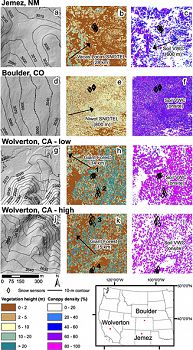Harpold et al., 2015
Soil moisture response to snowmelt timing in mixed-conifer subalpine forests
Harpold A. A., Molotch N. P., Musselman K. N., Bales R. C., Kirchner P. B., Litvak M. and Brooks P. D. (2015)
Hydrological Processes 29(12): 2782–2798 Cross-CZO
-
Boulder, Catalina-Jemez, INVESTIGATOR
-
Boulder, Sierra, INVESTIGATOR
-
Sierra, INVESTIGATOR
-
Sierra, GRAD STUDENT
-
Sierra, COLLABORATOR
-
Catalina-Jemez, INVESTIGATOR
Abstract
Light detection and ranging derived topography and vegetation structure in 250 ha surrounding the four field sites: topography and elevation (a, d, g and j), vegetation height (b, e, h and k) and vegetation density (c, f, i and l). Position of snow depth sensors are shown as diamond symbols. Middle panels show the distance and direction to climate stations. Right panels show distance and direction to soil moisture sensors. Inset shows location of study sites within Western US.
Western US forest ecosystems and downstream water supplies are reliant on seasonal snowmelt. Complex feedbacks govern forest–snow interactions in which forests influence the distribution of snow and the timing of snowmelt but are also sensitive to snow water availability. Notwithstanding, few studies have investigated the influence of forest structure on snow distribution, snowmelt and soil moisture response. Using a multi-year record from co-located observations of snow depth and soil moisture, we evaluated the influence of forest-canopy position on snow accumulation and snow depth depletion, and associated controls on the timing of soil moisture response at Boulder Creek, Colorado, Jemez River Basin, New Mexico, and the Wolverton Basin, California. Forest-canopy controls on snow accumulation led to 12–42 cm greater peak snow depths in open versus under-canopy positions. Differences in accumulation and melt across sites resulted in earlier snow disappearance in open positions at Jemez and earlier snow disappearance in under-canopy positions at Boulder and Wolverton sites. Irrespective of net snow accumulation, we found that peak annual soil moisture was nearly synchronous with the date of snow disappearance at all sites with an average deviation of 12, 3 and 22 days at Jemez, Boulder and Wolverton sites, respectively. Interestingly, sites in the Sierra Nevada showed peak soil moisture prior to snow disappearance at both our intensive study site and the nearby snow telemetry stations. Our results imply that the duration of soil water stress may increase as regional warming or forest disturbance lead to earlier snow disappearance and soil moisture recession in subalpine forests.
Citation
Harpold A. A., Molotch N. P., Musselman K. N., Bales R. C., Kirchner P. B., Litvak M. and Brooks P. D. (2015): Soil moisture response to snowmelt timing in mixed-conifer subalpine forests. Hydrological Processes 29(12): 2782–2798. DOI: 10.1002/hyp.10400
 This Paper/Book acknowledges NSF CZO grant support.
This Paper/Book acknowledges NSF CZO grant support.
Explore Further







